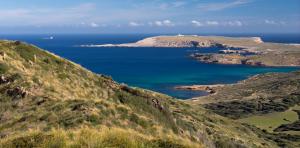
Grants
Sea
SOM Menorca | Study of migratory birds in the Mediterranean
6,000 awarded
TOTAL PROJECT COST – €13,400
CLOSED
- Organisation Applying for Funding: Societat Ornitològica de Menorca (SOM)
- Project Duration: 8 months – 2023 – IN PROGRESS
- Area of Interest: Sea – Research
- Other entities involved: San Luis Town Hall.
- Blog: https://illadelaire.wordpress.com/
LATEST UPDATES
Ver esta publicación en Instagram
THE PROJECT
Summary of the project
It is an ornithological and environmental research project that has been implemented on the island for 30 years, based on the technique of scientific austere ringing to obtain rigorous data on the passage of the different species of migratory passerines during the crossing of the Mediterranean Sea, from Africa to Europe, as they pass through Menorca. One of the main objectives is to deepen our knowledge of the importance of the small islands that are found during this journey for the survival of millions of these migratory birds.
Description of the project
An international study project started in Italy in 1988 with the participation of stations from France, Spain, Malta, Gibraltar and Greece, in addition to the Italian stations. The station of Menorca, Isla del Aire, began its journey in this international project in 1993, and the station has been active since then. Only in 2020 was it suspended due to the coronavirus pandemic.
It is a research project based on the technique of scientific bird ringing with the general objective of obtaining rigorous data on the passage of migratory passerine species as they cross the Mediterranean Sea. In order to obtain these data, it is essential to follow a series of pre-established guidelines, such as, for example, the use of the same metres of Japanese netting to capture the birds, the same location each year and the same fieldwork dates, both at our station and at the other stations participating in the international project. The specific work carried out each day is typical of any work based on ringing: checking the nets every hour, from sunrise to sunset, recording on the field sheets the species captured, the day and time of capture, and the age and sex of the ringed individuals, as well as taking a series of important biometric data (wing and third primary measurements, weight, physical condition and ring number).
The SOM also collaborates with the University of the Basque Country collecting feathers for the study of the presence of mercury in small migrant birds and with the “Wetland Ecology” department of the Doñana Biological Station, dependent on the CSIC, collecting parasites for the study of possible diseases carried by THE parasites that travel in migrant birds.
Among the main objectives of the project is the collection of data for the study of the migratory phenology of birds during prenuptial migration as they pass through the Mediterranean. Secondly, to investigate the importance of the small islands that the birds encounter during their crossing of this sea.
As mentioned above, the collection of data during long series serves to observe possible changes in the phenology and changes in the abundance of certain species during their passage along the Balearic route.
Main Objective
Deepen our knowledge of the importance of the small islands that are found during this journey for the survival of millions of these migratory birds.